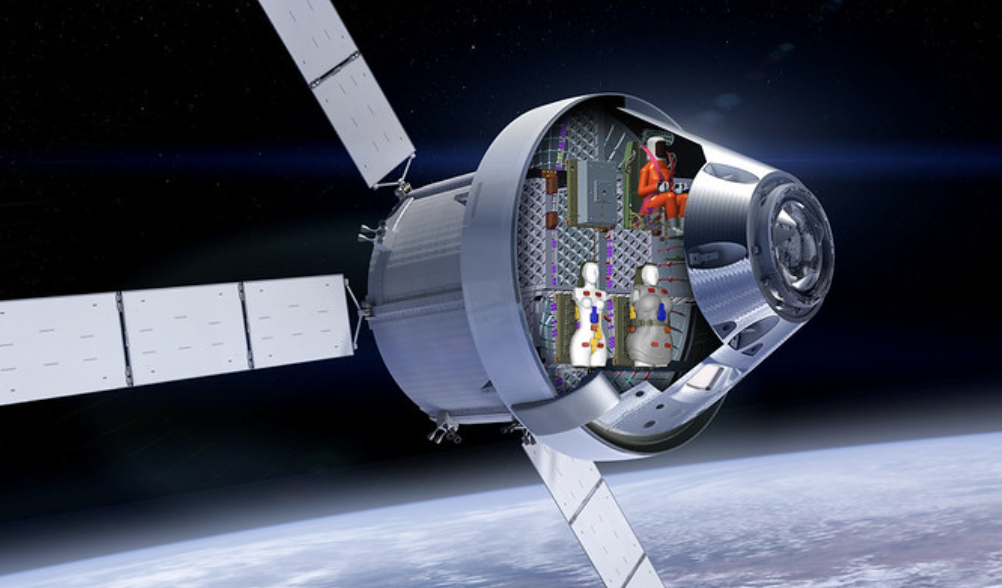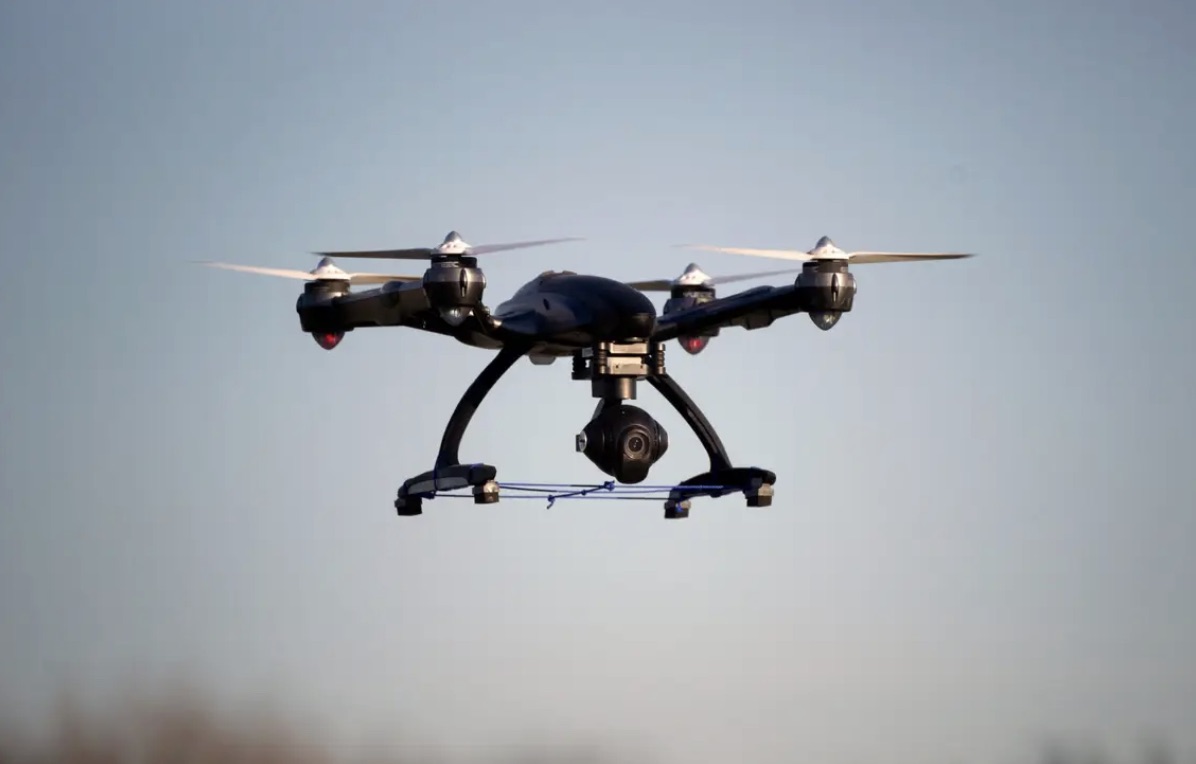The crew of Artemis II, who will be the first people to return to the Moon in over 50 years, recently visited the facility in Bremen, Germany where the European Service Module (ESM) is being built. This module is a crucial component of the spacecraft that will take them to the Moon.
In this article, BELLA RICHARDS discusses the challenges of developing the ESM and the importance of international cooperation in the Artemis program. Despite ongoing conflicts on Earth, the Artemis program stands as a symbol of unity and collaboration between nations.
The Apollo era will always be remembered as a pivotal period in space and science history. However, the Artemis program represents a new era of international cooperation in the space industry. Unlike Apollo, which was solely a US endeavor, Artemis is a global initiative. This collaboration serves as a positive example amidst ongoing international conflicts, even those extending into space.
In mid-September, as Germany joined the Artemis Accords as the 29th signatory nation, the Artemis II crew visited Bremen. Their visit aimed to meet the engineers and team responsible for developing the European Service Module (ESM), a critical component that will propel the Orion spacecraft to the Moon next year. The occasion also celebrated the collaborative spirit of the international team involved in the project.
Artemis Il astronauts speaking at a press conference in front of the Airhiis clean room on 1 September in Bremen, Germany.
Reid Wiseman, the commander of the Artemis II crew, emphasized the significance of international cooperation in the Artemis program, particularly highlighting Germany's recent signing of the Artemis Accords. He expressed pride in welcoming Germany to the growing global team committed to deep space exploration and the safe, sustainable use of space resources.
Wiseman also underscored the importance of the mutual support clause within the Artemis Accords, which ensures that astronauts in distress will receive assistance regardless of their nationality. This provision, he noted, offers reassurance to the crew knowing that they have a global support network. Despite ongoing tensions with Russia and China, Wiseman believes that space exploration has the unique power to unite nations and foster collaboration.
Artemis I and II: A New Era of Lunar Exploration
The Artemis program represents a pivotal moment in space exploration, marking the return of humans to the Moon after nearly 50 years. This ambitious endeavor, led by NASA in collaboration with global partners, signifies a paradigm shift in the space industry towards international cooperation.
Intearation of the crew and service modules for Artemis li at NAMAS Kennedy Space Center in Florida
Key Elements of Artemis I and II:
Artemis I: An uncrewed mission scheduled for launch in 2023, Artemis I will test the Orion spacecraft, Space Launch System, and the Gateway lunar outpost. This mission aims to pave the way for future crewed missions.
Artemis II: The first crewed mission in the Artemis program, Artemis II is scheduled for launch in 2024. This mission will carry astronauts around the Moon and back, marking a significant milestone in human spaceflight.
Global Collaboration:
The Artemis program is a testament to the power of international cooperation. Unlike the Apollo missions, which were solely led by the United States, Artemis involves a diverse group of partners, including:
European Space Agency (ESA)
German Aerospace Center (DLR)
Japan Aerospace Exploration Agency (JAXA)
Canadian Space Agency (CSA)
Israel Space Agency (ISA)
Italian Space Agency (ASI)
This collaboration signifies a new era of space exploration, where nations come together to achieve shared goals and advance scientific knowledge.
The Artemis Il service module at NASA's Kennedy Space Center in Florida.
Challenges and Opportunities:
Developing and executing missions of this scale presents numerous challenges, including:
Technical complexities of the spacecraft and launch systems
Logistics of coordinating international partners
Funding and resource allocation
Risks associated with deep-space exploration
However, these challenges are outweighed by the potential rewards of the Artemis program. This endeavor promises to:
Expand human presence in space
Advance scientific research on the Moon
Inspire a new generation of scientists and engineers
Foster international cooperation and peace
Looking Ahead:
The Artemis program is a daring and ambitious project that has the potential to revolutionize space exploration. By emphasizing international cooperation and scientific discoveries, Artemis could open doors for humanity to venture further into the universe than ever before.
The Artemis program kicked off with Artemis I, the inaugural mission in a series of lunar expeditions. It witnessed the Orion spacecraft, mounted atop the SLS rocket, launching from the Kennedy Space Center in Florida on November 16, 2022. This mission, spanning just under 26 days, aimed to showcase Orion's capabilities during various phases: launch, space travel, and return to Earth.
Should everything proceed as planned, Artemis II is scheduled for November 2024, marking two years since the launch of its predecessor. The flight crew for this mission includes NASA astronauts Commander Reid Wiseman, Pilot Victor Glover, and Mission Specialist Christina Koch, along with Canadian Space Agency astronaut Jeremy Hansen.
Artemis II, slated for November 2024, will be a ten-day mission focused on testing the capabilities of Orion and SLS with the help of the astronaut crew. Unlike Artemis I, which was uncrewed, this mission will carry astronauts around the Moon, marking a significant step forward in human spaceflight. This crucial mission will pave the way for future deep-space endeavors, including the highly anticipated lunar landing, the development of the Gateway space station orbiting the Moon, and the establishment of the Artemis base camp, a permanent human presence on the lunar surface.
Representatives from Airhiis. FA NANA and the Artemis Il astronauts in Bremen, Germany
European Power
A groundbreaking aspect of the Artemis missions is the European Service Module (ESM), marking the first instance of an American spacecraft relying on a European-built system for power. The ESM plays a vital role in providing essential resources to the Orion spacecraft, including electricity, water, oxygen, and nitrogen.
In 2013, NASA selected the European Space Agency (ESA) to contribute to the Artemis project. Since then, ESA has been entrusted with the development of the ESM for missions up to Artemis 6, investing a substantial €2 billion in the program. Airbus Defence and Space was chosen by ESA to construct the system, and a workforce of over 3,000 individuals across 60 different companies in Europe is dedicated to its development.
Marc Steckling, Head of Space Exploration at Airbus, revealed during a press briefing that the company has submitted two proposals to ESA for further development of the module for Artemis missions 7 through 9. Additionally, Steckling affirmed that the ESM-3 remains on schedule for delivery to the Kennedy Space Center from Bremen later this year, likely in December.
The Artemis II astronauts' visit to Bremen marked their first encounter with the ESM, a critical system that will sustain their basic needs during the space mission. According to the ESA, the ESM has a launch mass of 13,500kg, contributing to 60% of Orion's total mass. This cylindrical system, approximately 4m in both diameter and height, houses a total of 33 engines for powering the spacecraft, similar to the Starship. The primary engine, repurposed from the Orbital Manoeuvring System used in previous Shuttle missions, provides 25.7kN of thrust. Additionally, eight R-4D-11 auxiliary thrusters, each delivering 490N, serve as backups and facilitate orbital adjustments. Lastly, 24 smaller Reaction Control System engines, arranged in six pods, are responsible for altitude control. Once launched and free from the rocket fairing, the ESM will deploy its solar array, expanding to a span of 19m.
The roots of the ESM can be traced back to the European Space Agency's Automated Transfer Vehicle (ATV). This spacecraft, much like Russia's Progress vehicle, was primarily utilized for transporting cargo to the International Space Station (ISS). The ATV program operated between 2008 and 2014, completing a total of five launches. However, when concerns about the rising expenses of the Artemis program emerged, a decision was made to adapt the ATV design for the Orion service module. This calculated move enabled substantial reductions in both the cost and time involved in developing the ESM.
Thanks to advancements in technology, the ESM offers several advantages over the Block II Apollo command and service module (CSM) produced by North American Rockwell in the 1960s. The CSM was smaller, measuring just under 3m in diameter. The ESM, on the other hand, utilizes solar arrays instead of fuel cells, enabling it to generate more electricity while being significantly lighter. Furthermore, the ESM boasts a longer endurance, capable of supporting deep-space missions for up to 20 days compared to the CSM's 14-day limit.
Artemis I was a resounding success for ESA's ESM. Airbus Defence and Space, the manufacturer, reported that the inaugural flight provided a wealth of valuable data and that all mission objectives were met. The Orion spacecraft demonstrated impressive efficiency, consuming less propellant and electrical power than anticipated while generating more power. The propulsion subsystem performed flawlessly, enabling precise orbital maneuvers and attitude control, and even allowing for additional flight tests.
Furthermore, the main engine operated as planned, firing multiple times with a total burn time of ten minutes. The mission concluded with a significant amount of propellant remaining—almost two tonnes—suggesting potential for extended mission durations in the future. Notably, the solar arrays exceeded expectations by generating 15% more power, likely due to the spacecraft's lower-than-expected electricity consumption resulting from smaller temperature fluctuations.
From ATV to ESM
Adapting the ESM from the existing ATV platform presented both challenges and advantages for engineers. The primary challenge, as outlined by Steckling, was transforming it into a vehicle capable of supporting human life, rather than simply transporting cargo. "The ATV was not designed for human transport, and this is fundamentally the key distinction between it and the ESM."
"Certainly, we had to enhance the overall design to ensure it was safer than the ATV, even though the ATV successfully docked with the International Space Station. However, some aspects were less intricate because the ATV already possessed the onboard sensors required for approaching, docking, and delivering cargo to the ISS. So, from a structural perspective, it was simpler, but we also needed to integrate the human element," he elaborated. The primary enhancement for the ESM was the addition of nitrogen, water, and oxygen systems to support human life.
Artemis I served as the first significant test of the ESM's capabilities, and it provided Airbus and ESA with the confirmation that it had been built to near perfection. Steckling remarked, "What we learned on the first mission didn't necessitate any changes for the second one \[Artemis III." He explained that the team had expected to make modifications between the first and second ESM due to the inherent differences between space missions and ground simulations. However, they were fortunate that the spacecraft performed exactly as planned, eliminating the need for delays in Artemis II.
Learning from Apollo 13
The Apollo 13 mission, the seventh lunar mission in 1970, faced a critical oxygen tank failure. Astronauts Jim Lovell, Jack Swigert, and Fred Haise, along with the mission control team, worked tirelessly to ensure their safe return. Although the spacecraft never reached the Moon, they successfully navigated back to Earth by looping around the Moon and utilizing its gravity, as well as the Lunar Module's engine for propulsion.
The Apollo 13 mission faced a critical setback, preventing the spacecraft from reaching the Moon. However, through ingenuity and collaboration, the astronauts and mission control devised a solution. They looped around the Moon, utilizing its gravitational pull, and employed the Lunar Module's engine for propulsion, successfully guiding the crew back to Earth safely.
Learning from Apollo 13
The Apollo 13 mission, the seventh lunar mission in 1970, faced a critical oxygen tank failure. Astronauts Jim Lovell, Jack Swigert, and Fred Haise, along with the mission control team, worked tirelessly to ensure their safe return. Although the spacecraft never reached the Moon, they successfully navigated back to Earth by looping around the Moon and utilizing its gravity, as well as the Lunar Module's engine for propulsion.
Contingency Plans for Artemis II
For Artemis II, a significant emphasis is placed on developing contingency plans for various scenarios. Victor Glover stated, "Not just Apollo 13, but in general, we learn a lot from missions we fly, and we implement the things I think will help us hopefully address those things that we encounter." This approach underscores the importance of learning from past experiences and proactively implementing measures to mitigate potential risks in future missions.
Glover explained that the teams have meticulously analyzed every conceivable risk and potential failure to ensure preparedness for any situation during the mission. He emphasized the focus on redundancy and manual intervention capabilities within the Orion spacecraft. This approach allows the crew to maintain a comprehensive understanding of the spacecraft's trajectory, its operational status, and any issues that may arise within its subsystems.
Furthermore, Wiseman added that the Orion spacecraft has been built in a way that the astronauts and mission control will know all the failure modes and be prepared for any scenario.
"But at the end of the day, something can go wrong that you don't expect and that's why human ingenuity starts to creep its way in, and we may have to solve problems that haven't been thought of and we will work with ground teams and we will get them done," Wiseman said.
The Artemis II team is undergoing an 18-month training program that commenced in June of this year. This intensive training focuses on familiarizing the crew with the spacecraft's critical systems, such as its displays, vehicle controls, audio, and imagery systems. Currently, the crew is awaiting the certification and integration of the Orion simulator at NASA's Johnson Space Center in Houston, Texas. This simulator will provide a realistic environment for the astronauts to practice and refine their skills before the mission.
Finally, Jeremy Hansen said that the international team is setting an example to the rest of humanity in working together to solve problems.
"In Apollo 13, it gets really bad, and it gets to the point where there's kind of an iconic scene there where the flight director [the legendary Gene Kranz) stops everybody, because they have all got a failure to report, and he says 'okay, tell me what weve got left on a spacecraft that's good' - he flipped the problem on its head because it doesn't fit the current model that we use day to day," Hansen said.
"I love this because it highlights the current global situation and emphasizes the importance of international cooperation. It's easy to focus on failures, but we need to shift our perspective and identify our strengths and resources."
Trusting in the Global Four-Party Team
The Artemis program is a testament to the collective efforts of a four-party team: NASA, ESA (including its 22 member states), Lockheed Martin, and Airbus Defence and Space. Unlike the Apollo missions, which were primarily led by the United States, Artemis represents a paradigm shift towards international collaboration. This global partnership has instilled a deeper sense of trust in the Artemis astronauts, who feel confident in the capabilities of the system and the unwavering commitment of the team dedicated to their safety.
Christina Koch highlighted the importance of meeting the European team members who will be in the control room during the mission, as it strengthened her trust in the spacecraft's safety. She stated, "We were just in the clean room, and we met the people that are doing every little piece of tape, every connection, every mechanical and electrical connector... now when people ask us, 'are you nervous about this flight, and we say things like we implicitly trust the engineers and the technicians that build this vehicle. Now we've met them, we've seen their work, we'tve seen how well they do it and how dedicated they are. And that is what matters about this cross-cultural work." This personal interaction with the team behind the spacecraft fostered a deeper sense of trust and confidence in the mission's success.
Countdown to Artemis
The historic launch of Artemis II is fast approaching, and preparations are in full swing. On September 25, NASA announced that all four RS-25 engines had been successfully installed onto the core stage of the SLS at the Michoud Assembly Facility in New Orleans. This significant milestone was followed by the completion of the first integrated ground system test in Florida on September 20. This test allowed the astronauts to practice launch day procedures in a simulated environment. These recent developments build upon the earlier achievement of integrating all five major structures of the core stage earlier this spring.
Fifty years after Gene Cernan and Harrison Schmitt left the lunar surface on December 14, 1972, humans are once again poised to return to the Moon. This time, however, Europe is an integral part of the program, contributing significantly to the development of the Orion spacecraft and the European Service Module (ESM).
The Artemis II Crew
The Artemis II crew comprises four astronauts: Commander Reid Wiseman, Pilot Victor Glover, Mission Specialist Christina Koch, and Canadian Space Agency astronaut Jeremy Hansen. This diverse team has undergone rigorous training in preparation for the mission, which will see them travel around the Moon and back.
The European Service Module (ESM)
The ESM is a crucial component of the Orion spacecraft, providing it with power, water, oxygen, and nitrogen. Developed by Airbus Defence and Space, the ESM represents a significant contribution from Europe to the Artemis program. This innovative module draws upon the legacy of the Automated Transfer Vehicle (ATV), which was used to resupply the International Space Station (ISS) between 2008 and 2014.
International Collaboration
The Artemis program is a testament to the power of international collaboration. Unlike the Apollo missions, which were primarily led by the United States, Artemis involves a diverse group of partners, including:
European Space Agency (ESA)
German Aerospace Center (DLR)
Japan Aerospace Exploration Agency (JAXA)
Canadian Space Agency (CSA)
Israel Space Agency (ISA)
Italian Space Agency (ASI)
This collaboration signifies a new era of space exploration, where nations come together to achieve shared goals and advance scientific knowledge.
Challenges and Opportunities
Developing and executing missions of this scale presents numerous challenges, including:
Technical complexities of the spacecraft and launch systems
Logistics of coordinating international partners
Funding and resource allocation
Risks associated with deep-space exploration
However, these challenges are outweighed by the potential rewards of the Artemis program. This endeavor promises to:
Expand human presence in space
Advance scientific research on the Moon
Inspire a new generation of scientists and engineers
Foster international cooperation and peace
Looking Ahead
The Artemis program is a bold and ambitious undertaking that promises to rewrite the history of space exploration. With its focus on international collaboration and scientific discovery, Artemis has the potential to pave the way for a future where humanity can explore the universe further than ever before.













0 Comments